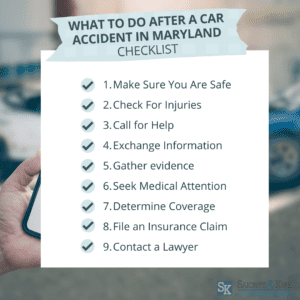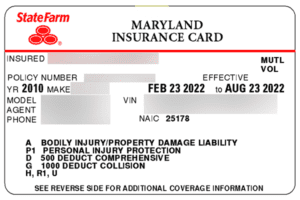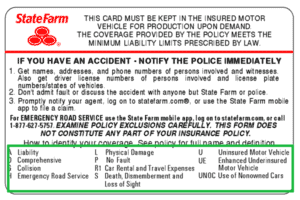Steps to take after a car accident in Maryland
If you or a loved one are involved in a car accident in Maryland, ensuring the safety of yourself, passengers, and others involved in the accident should always be your number one priority. However, it is important to know what additional steps you should take to protect your legal rights.
Our team of Maryland car accident lawyers have compiled a series of steps to take following a car crash to help guide you through the process.
What to do after a Car Accident Checklist
Click the image to download the full size checklist

What to do after a Car Accident (Video Guide)
9 Steps to take: What to do after a Car Accident in Maryland
A car crash can be a traumatic experience that creates confusion and panic depending on the severity of the accident. In those moments of confusion immediately following an accident people are often at a loss about what to do after a car accident.
Should they call the police? Should they call an attorney? Is it important to take pictures? Should they see a doctor? After an auto accident you may have a lot of questions. As one of the leading law firms with decades of experience helping people with Maryland auto accidents, we want to give you some straightforward steps for follow so you know what to do after an accident.
What to do after a Car Accident (Steps on this page)
Step 1. Make Sure You Are Safe
Step 2. Check For Injuries
Step 3. Call for Help
Step 4. Exchange Information
Step 5. Gather Evidence
Step 6. Seek Medical Attention
Step 7. Determine Car Insurance coverage
Step 8. File a Claim with your Insurance company
Step 9. Contact A Maryland Car Accident Lawyer
Step 1 – Make sure you are safe
Your first priority at the scene of the accident is to make sure that you are safe. Do not further endanger yourself of the other driver by getting out of the car in the middle of the road.
- Turn off your car to assess the situation
- Turn on your hazard lights or emergency flashers
- Make sure you are in a safe location before you exit your car. Far too often people get out of their car immediately after an accident to check for damage, only to get struck by another car on the road.
- Do not move your vehicle unless you believe it poses a significant safety risk to other drivers or yourself (ex: your car is facing oncoming traffic). You should wait for the police to arrive so they can make an accurate police report.
Step 2 – Check For Injuries
The second step following any automobile accident should be to check yourself and your passengers for injuries. It is important to know that auto accident injuries can be both apparent, such as cuts or bone protrusions, or non-visible such as traumatic brain injuries or internal bleeding which can be life threatening.
Some of the most common car accident injuries can include;
- Whiplash and Neck Injuries
- Soft Tissue Injuries
- Fractures and Broken Bones
- Traumatic brain injuries (TBIs)
- Spinal cord injuries and paralysis (SCIs)
- Internal injuries
If you believe anyone has sustained a severe or life threatening injury from the car accident you should dial 9-1-1 immediately for medical assistance.
Step 3 – Call for help
Call 911 or Non-Emergency Services
If anyone was injured in the accident or there was property damage, you should call 911. If the accident was minor and nobody was injured than you can call your local Maryland non-emergency services phone number.
911 and non-emergency dispatch services can coordinate getting both an ambulance and the police on the way to accident scene if necessary.
Maryland Non-Emergency Services Phone Numbers by County
Even if you believe the injuries are minor, it is better to be safe than sorry. It is important to relay to the dispatcher if there are injuries on the scene so medical aid can be dispatched as quickly as possible.
Call the Police
In most states, if there is serious property damage or personal injury, you must call the police. It is important to relay to the dispatcher if there are injuries on the scene so medical aid can be dispatched as quickly as possible. Also, some jurisdictions may refuse to send an officer to the scene of the accident if there is not significant damage or personal injury, which means there will not be an official report of the incident.
Even if the accident is minor, you should call the police and wait at the scene of the accident so that there is a record of what happened and the incident is on file to hold the other party accountable.
Another important reason for calling the police is to help facilitate the exchange of information with the other driver involved in the accident. Many times following an accident, tempers can flare and people become argumentative which can make for a hostile situation. The police can help calm the situation and so you can the other driver can exchange contact information, especially if you believe the other driver was at fault.
Step 4 – Exchange Information
It is important to make sure you to collect the following information from the other driver and from the police report.
Other Driver’s Contact Information
- other driver’s name, phone number and address
- other driver’s driver’s license number
- other driver’s license plate number
Other Driver’s Insurance Information
Make sure you get all of the other driver’s insurance company information. The easiest way get the other driver’s insurance information is to take a picture (both front and back) of their insurance card including:
- other driver’s insurance company name
- other driver’s policy number and policy limits
- other driver’s VIN number
- other driver’s year, make, model of their car
Example of other driver’s insurance card

Police Report Information
If the police arrive at the scene, they will file a police report for the accident. If you cannot get the police to come to the scene of the accident, you may have to go to the nearest police station.
Make sure you get the police report number, you will need this number later to get access the final police report. You should also collect information of any police officers on the scene including the police officer’s name, contact information and badge numbers
The police accident report will contain a lot of important information. You will need to get the most value from your car accident settlement:
- Witness statements
- Property damage assessment
- Narrative of who was the at fault driver
- Where the accident happened
- What time the accident occurred
- Vehicles involved
- Vehicle location
Do Not Discuss Fault
Do not discuss fault of the accident with the other driver, especially if you believe it was the other driver’s fault. These conversations can turn confrontational very quickly and offer no benefit to your case. Wait until the officer arrives and follow his instructions. Give only information you are certain of, and do not guess or estimate speeds.
Step 5 – Gather Evidence
If you are not severely injured and aid to other parties of the accident is not required, begin gathering evidence of the accident while the police officers are in route.
Witnesses
You should immediately seek out any witnesses and collect their names and contact information. Far too often witnesses who support your side of the case continue driving or walk away before the police arrive. Ask the witnesses to stay at the scene of the accident until the officers arrive to give a statement.
Vehicle Damage Photos
Take photos of the scene of the accident, including the vehicles involved and the areas of impact such as front or rear bumpers, skid marks, debris and other details that can be used to reconstruct the crash and establish fault of the accident.
Accident Location Photos
Take pictures of the accident location and any relevant cross streets or signage such as stop signs or one-way signals that could be used to help support your case if the officer fails to document these details.
Step 6 – Seek Medical Attention
After a car accident, the most important thing you can do is to seek medical attention as soon as possible. Even if you don’t think you’ve been injured, it’s important to see a doctor and get medical treatment immediately after the accident.
Many times people involved in car accidents (even in a minor fender bender) do not notice injury symptoms until a few days, weeks or sometimes months after an automobile accident. With the exception of serious injuries, most of the common injuries after a car accident can take some time to show up.
Some injuries such as whiplash soft tissue and spinal injuries may not present themselves immediately but can still cause long-term problems. By seeing a doctor right away, you can get started on the proper treatment program and begin the road to recovery and potentially minimize any medical expenses.
Make sure that you keep notes and dates of all your doctor’s visits and medical records. This information will come up in your accident settlement negotiations.
Step 7 – Determine car insurance coverage
When an accident occurs, it is important to identify what type of car insurance coverage that you have available. Check with your insurance provider to see if you have extra features beyond liability coverage like PIP, or medpay You have more options available to you if you get into an accident and the other driver is at fault.
If the other driver is determined to be at fault then the at fault driver’s policy should cover:
- Property damages to your car. The total amount is based on the other driver’s policy limit
- Medical bills and expenses for you and other passengers in your car. The total amount is based on the other driver’s policy limits
- Any other damages associated with your pain and suffering.
Depending on your car insurance policy may cover the following:
- PIP coverage, also known as personal injury protection. This is an optional, no-fault auto insurance coverage. In Maryland, PIP coverage provides immediate funds to cover lost wages and medical bills if you’re injured in a motor vehicle accident.
- Uninsured or Underinsured Motorist Coverage (UM) is an insurance policy addon that is required in Maryland (some states do not require it). UM insurance will cover both property and medical expenses if the at fault-driver has insufficient policy limits. For example if the other driver had a policy limit of $10,000 and you had $20,000 worth of expenses/damages, then your UM coverage could cover the difference of $10,000.
- Rental Car Coverage. If your insurance policy includes comprehensive coverage or collision coverage, then it most likely includes covering the cost of renting a car after an accident.
Example of Coverage Options from back of a Maryland insurance card

Step 8 – File a Claim with your Insurance company
You should contact your insurance company and notify them within 24 hours of the accident to file a car insurance claim, even if you believe you are not at fault. Failure to report the accident and file an auto insurance claim with your own insurance carrier within a timely fashion could result in the loss of coverage.
File a claim by calling the phone number on your auto insurance card or you can also download your insurance company’s mobile app on your phone.
- Your insurance company will assign you an insurance claims adjuster.
- The insurance adjuster will investigate the accident and determine who was at fault.
- Once that determination is made, your insurance company will start the insurance claim settlement process.
While you should uphold your responsibility in reporting the accident to your insurance company, you should keep in mind car insurance companies are not always on your side and have their own set of car accident insurance claim tactics to reduce the amount of money they will have to pay you to cover medical expenses and property damage.
Things to remember when dealing with the insurance companies.
- You should refrain from making statements about injuries or fault. You can simply tell your insurance company that you are seeking treatment for any possible injuries you may have sustained from the accident, and that your attorney can discuss who was at fault.
- Do not give any recorded or official statements.
- Do not talk to the other driver’s insurance provider.
Step 9 – Contact A Maryland Car Accident Lawyer
While many insurance companies will lead you to believe that they have your best interest in mind, remember that insurance companies thrive by collecting premiums, not by justly compensating victims of car accidents with the appropriate car accident settlement funds for injuries, property damage and pain and suffering.
The best chance of getting the compensation you deserve for your injuries, pain and suffering is by having an experienced Maryland car accident lawyer who can help you navigate the complex legal process and fight for the compensation you deserve.
Unfortunately, serious car accidents and large truck accidents in Maryland are far too common. If you or someone you love has been involved in a car accident, it is important to seek legal assistance as soon as possible. An experienced Maryland car accident lawyer can help you navigate the complex legal process and fight for the compensation you deserve.
The attorneys and staff at Saiontz and Kirk have decades of experience making sure that our clients are fully compensated for all injuries you may have suffered due to a Maryland auto accident. Call us for a free consultation at 1-800-522-0102 or request a free consultation with the form below.
